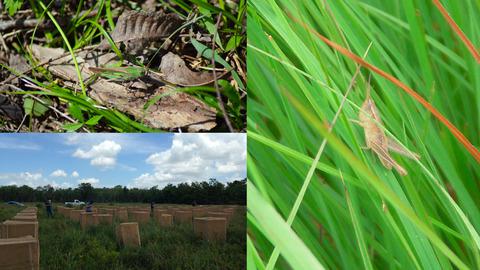当前位置:
X-MOL 学术
›
Funct. Ecol.
›
论文详情
Our official English website, www.x-mol.net, welcomes your feedback! (Note: you will need to create a separate account there.)
Functional and taxonomic diversity of grasshoppers differentially shape above‐ and below‐ground communities and their function
Functional Ecology ( IF 5.2 ) Pub Date : 2020-09-24 , DOI: 10.1111/1365-2435.13682 Jane M. Lucas 1 , Jayne Jonas 2 , Angela N. Laws 3, 4 , David H. Branson 5 , Steven C. Pennings 3 , Chelse M. Prather 6 , Michael S. Strickland 1
中文翻译:

蝗虫的功能和分类多样性不同地影响了地下和地下社区及其功能
更新日期:2020-09-24
Functional Ecology ( IF 5.2 ) Pub Date : 2020-09-24 , DOI: 10.1111/1365-2435.13682 Jane M. Lucas 1 , Jayne Jonas 2 , Angela N. Laws 3, 4 , David H. Branson 5 , Steven C. Pennings 3 , Chelse M. Prather 6 , Michael S. Strickland 1
Affiliation

|
- Herbivores are important drivers in both above‐ and below‐ground ecosystems. Despite their importance, studies of herbivores often focus on the effects of individual species, potentially missing the effects of herbivore diversity.
- Here we examine how orthopteran herbivore species and functional (i.e. diet) diversity interact with nutrient availability to shape above‐ and below‐ground ecosystems. We stocked six species of grasshoppers (Orthoptera) with two different feeding modes (i.e. grass‐only or grass‐ and forb‐feeders) at varying taxonomic compositions (0, 1 or 6 species) in field enclosures and measured their effects on above‐ground plant biomass, chemistry and richness, as well as below‐ground microbial community composition and function. We treated half the cages with nitrogen fertilizer to examine how herbivore effects may be mitigated by soil nutrient availability.
- Above‐ground, we predicted that grasshoppers would decrease plant biomass and richness, and increase the %N of the plant community. We also predicted that high diversity cages would have the largest decreases in plant biomass and richness, but these effects would be offset by fertilizer additions.
- Below‐ground, we predicted that herbivore taxonomic composition and diet would differentially shift soil microbial community composition and function. We also predicted that fertilization would decrease the soil pH and increase nutrient availability creating an interaction with herbivores that leads to shifts below‐ground community composition.
- We found that grasshoppers decreased plant biomass and richness, and this effect was not dependent on nutrient additions. Contrary to our predictions, we did not see the largest above‐ground changes in high diversity cages.
- Below‐ground, herbivore diet and fertilization, but not their interaction, shifted bacterial communities. Grasshopper taxonomic composition did not influence bacterial communities. Grasshopper taxonomic composition and diet interacted with fertilizer to increase below‐ground levels of bioavailable C and microbial biomass. Fungal communities did not respond to any treatments.
- The differing effects of herbivore diet versus taxonomic composition highlight the need for studies that examine multiple diversity metrics when exploring herbivore‐meditated effects on above‐ and below‐ground ecosystems. Combined, our results suggest that bottom‐up and top‐down controls are important factors to consider when studying the composition and function of grassland ecosystems.
中文翻译:

蝗虫的功能和分类多样性不同地影响了地下和地下社区及其功能
- 草食动物是地上和地下生态系统的重要驱动力。尽管具有重要意义,但草食动物的研究通常侧重于单个物种的影响,可能会遗漏草食动物多样性的影响。
- 在这里,我们研究直翅目草食动物种类和功能性(即饮食)多样性如何与养分有效性相互作用,从而形成地上和地下生态系统。我们在田间围场中以不同的生物分类组成(0种,1种或6种)放养了六种蚱two(直翅目),它们有两种不同的饲养方式(即仅草饲或草饲和Forb-feeder),并测量了它们对地面的影响植物生物量,化学物质和丰富度,以及地下微生物群落的组成和功能。我们用氮肥处理了一半的网箱,以研究土壤养分的可获得性如何减轻草食动物的影响。
- 在地上,我们预测蝗虫会减少植物的生物量和丰富度,并增加植物群落的%N。我们还预测,高多样性的网箱将使植物生物量和丰富度的下降幅度最大,但这些影响将被肥料的添加所抵消。
- 在地下,我们预测草食动物的生物分类学组成和饮食会差异性地改变土壤微生物群落的组成和功能。我们还预测施肥会降低土壤的pH值并增加养分的利用率,从而与草食动物发生相互作用,从而导致地下群落组成发生变化。
- 我们发现蚱hopper降低了植物的生物量和丰富度,这种作用不依赖于营养物的添加。与我们的预测相反,我们没有看到高多样性网箱中最大的地上变化。
- 地下,草食动物的饮食和施肥,而不是它们之间的相互作用,改变了细菌群落。蝗虫的生物分类组成不影响细菌群落。蝗虫的生物分类组成和饮食与肥料相互作用,以提高地下生物利用碳和微生物生物量的水平。真菌群落对任何治疗均无反应。
- 食草动物饮食与生物分类组成的不同影响突显了在研究食草动物对地上和地下生态系统的影响时研究多重多样性指标的研究的必要性。综合来看,我们的结果表明自下而上和自上而下的控制是研究草地生态系统的组成和功能时要考虑的重要因素。



























 京公网安备 11010802027423号
京公网安备 11010802027423号